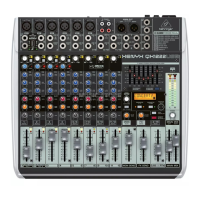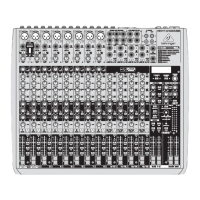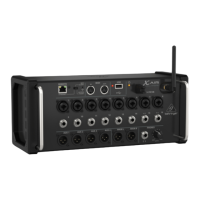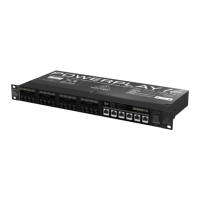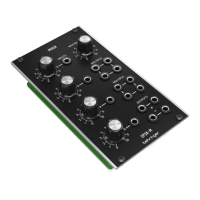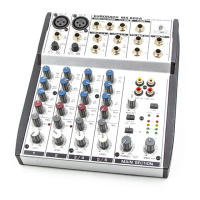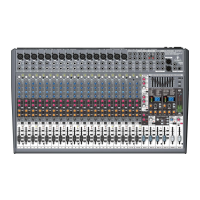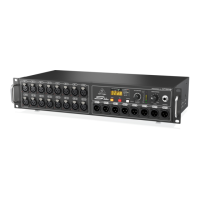Do you have a question about the Behringer Xenix 302USB and is the answer not in the manual?
Key safety instructions for operating the device, including precautions against electric shock and fire hazards.
Crucial warnings regarding electrical shock, water exposure, and proper handling of the apparatus.
Statement regarding technical specifications, trademarks, and limitations of liability.
Information on warranty terms and conditions, directing users to the website for full details.
Illustrates connecting microphones (XM8500) and stereo sources (e.g., DVD player) to the mixer.
Diagram showing connections for live recording using digital recorder and instruments.
Diagram illustrating connections for a project studio with speakers and keyboard.
Important note on connecting headsets with built-in microphones to avoid unwanted noise.
Explains the LINE/USB FROM and 2-TRACK TO buttons for selecting input sources and routing outputs.
Details how to adjust channel gain sensitivity and stereo positioning using PAN/BAL sliders.
Describes the PHONES knob for headphone volume and the POWER LED status indicator.
Explains the MIC knob for adjusting microphone and headset input volumes.
Describes SIG/CLIP LEDs for signal presence and overload, and CLIP LED for input clipping.
Details the LINE/USB knob for input/return volume and the MAIN MIX knob for output level adjustment.
Steps for powering off devices, connecting cables, and setting initial knob positions before powering on.
Procedure for setting the GAIN knob to achieve proper input levels without clipping.
Guide on using LINE/USB FROM and TO buttons to select audio sources and destinations.
Instructions for adjusting the headphone volume using the PHONES knob.
Steps for connecting the mixer via USB and selecting it as the audio device.
Instructions for downloading and installing BEHRINGER USB Audio Driver or ASIO4ALL for Windows.
Guide on selecting 'USB Audio CODEC' as the sound card for input and output in system audio settings.
Important note to disable 'software thru' function during recording to avoid unwanted effects.
Details on microphone input type, EIN, frequency response, gain range, and impedance.
Specifications for stereo line inputs and 2-Track inputs, including type, impedance, and max level.
Specifications for the headset mic input and the equalizer frequency bands (Low/High).
Details on main and headphone output levels, system noise data, and external power supply.
Detailed technical data for microphone input, including SNR, distortion, and frequency response.
Specifics for line, 2-track, and headset mic inputs, covering impedance and maximum levels.
Details on equalizer bands, main and headphone output types, and maximum levels.
Information on system noise, power supply, USB connector type, and sample rate.
Key parameters for microphone input, including type, EIN, frequency response, and impedance.
Specifications for line, 2-track, and headset mic inputs, covering gain, max level, and impedance.
Details on equalizer frequency bands, main and headphone output types, and maximum levels.
Information on system noise, power supply, USB connector type, dimensions, and weight.
Instructions to register new equipment online for faster repair claims and warranty information.
Guidance on contacting MUSIC Group for support if local resellers are unavailable.
Ensuring correct mains voltage and fuse replacement procedures for safe power connections.
Statement on compliance with FCC rules for Class B digital devices and protection against harmful interference.
Recommended measures to correct radio or television reception interference if it occurs.
Conditions for device compliance with FCC rules, including non-interference and acceptance of received interference.
Information that unauthorized modifications can void the user's authority to operate the equipment.
Key safety instructions for operating the device, including precautions against electric shock and fire hazards.
Crucial warnings regarding electrical shock, water exposure, and proper handling of the apparatus.
Statement regarding technical specifications, trademarks, and limitations of liability.
Information on warranty terms and conditions, directing users to the website for full details.
Illustrates connecting microphones (XM8500) and stereo sources (e.g., DVD player) to the mixer.
Diagram showing connections for live recording using digital recorder and instruments.
Diagram illustrating connections for a project studio with speakers and keyboard.
Important note on connecting headsets with built-in microphones to avoid unwanted noise.
Explains the LINE/USB FROM and 2-TRACK TO buttons for selecting input sources and routing outputs.
Details how to adjust channel gain sensitivity and stereo positioning using PAN/BAL sliders.
Describes the PHONES knob for headphone volume and the POWER LED status indicator.
Explains the MIC knob for adjusting microphone and headset input volumes.
Describes SIG/CLIP LEDs for signal presence and overload, and CLIP LED for input clipping.
Details the LINE/USB knob for input/return volume and the MAIN MIX knob for output level adjustment.
Steps for powering off devices, connecting cables, and setting initial knob positions before powering on.
Procedure for setting the GAIN knob to achieve proper input levels without clipping.
Guide on using LINE/USB FROM and TO buttons to select audio sources and destinations.
Instructions for adjusting the headphone volume using the PHONES knob.
Steps for connecting the mixer via USB and selecting it as the audio device.
Instructions for downloading and installing BEHRINGER USB Audio Driver or ASIO4ALL for Windows.
Guide on selecting 'USB Audio CODEC' as the sound card for input and output in system audio settings.
Important note to disable 'software thru' function during recording to avoid unwanted effects.
Details on microphone input type, EIN, frequency response, gain range, and impedance.
Specifications for stereo line inputs and 2-Track inputs, including type, impedance, and max level.
Specifications for the headset mic input and the equalizer frequency bands (Low/High).
Details on main and headphone output levels, system noise data, and external power supply.
Detailed technical data for microphone input, including SNR, distortion, and frequency response.
Specifics for line, 2-track, and headset mic inputs, covering impedance and maximum levels.
Details on equalizer bands, main and headphone output types, and maximum levels.
Information on system noise, power supply, USB connector type, and sample rate.
Key parameters for microphone input, including type, EIN, frequency response, and impedance.
Specifications for line, 2-track, and headset mic inputs, covering gain, max level, and impedance.
Details on equalizer frequency bands, main and headphone output types, and maximum levels.
Information on system noise, power supply, USB connector type, dimensions, and weight.
Instructions to register new equipment online for faster repair claims and warranty information.
Guidance on contacting MUSIC Group for support if local resellers are unavailable.
Ensuring correct mains voltage and fuse replacement procedures for safe power connections.
Statement on compliance with FCC rules for Class B digital devices and protection against harmful interference.
Recommended measures to correct radio or television reception interference if it occurs.
Conditions for device compliance with FCC rules, including non-interference and acceptance of received interference.
Information that unauthorized modifications can void the user's authority to operate the equipment.
| Type | Analog Mixer |
|---|---|
| Aux Send | No |
| USB | 1 x Type B |
| Phantom Power | +48V |
| EQ Bands | 2-band |
| Power Supply | External power supply |
| Headphone Output | 1 |
| Main Outputs | 2 |

